Mitsubishi Mirage (2022 year). Manual in english - page 11
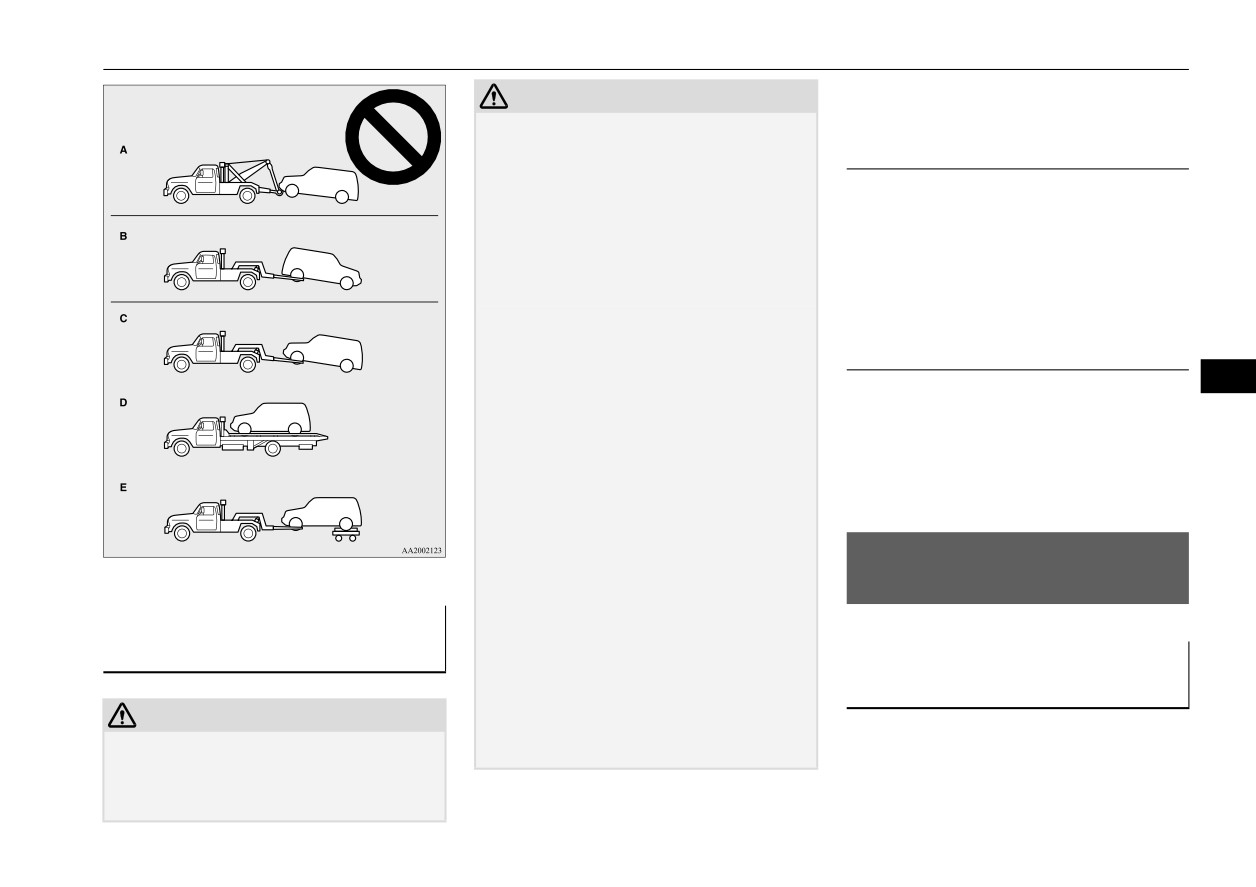
Operation under adverse driving conditions
CAUTION
Towing with rear wheels off the
z
Do not tow continuously variable transmis-
ground (Type B - manual transaxle
sion (CVT) vehicles with the driving wheels
vehicles only)
on the ground (Type B) as illustrated. If the
vehicle is towed like this, the continuously
variable transmission (CVT) fluid may not
Set the gearshift lever to the “N” (Neutral)
reach all parts of the transmission, thus dam-
position.
Do not tow CVT vehicles with this style.
aging it.
Secure the steering wheel in a straight-ahead
If you tow CVT vehicles, use Type C, D or E
position with a rope or tie-down strap.
equipment.
z
If the manual transaxle is malfunctioning or
Towing with front wheels off the
damaged, transport the vehicle with the driv-
ing wheels on a carriage (Type C, D or E) as
ground (Type C)
illustrated.
8
z
If the vehicle is towed with the ignition
Release the parking brake.
switch in the “ON” position or the operation
Place the gearshift lever in the “N” (Neutral)
mode in ON and only the front wheels or
position
(manual transaxle) or the selector
only the rear wheels raised off the ground
lever in the
“N”
(NEUTRAL) position
(Type B or C), the Active Stability Control
(CVT).
(ASC) may operate, resulting in an accident.
When towing the vehicle with the rear
wheels raised, turn the ignition switch to the
Operation under adverse
“ACC” position or put the operation mode in
ACC. When towing the vehicle with the
driving conditions
front wheels raised, keep the ignition switch
N00837201799
Towing the vehicle by a tow
or the operation mode as follows.
[Except for vehicles equipped with the
truck
If your vehicle becomes stuck in
F.A.S.T.-key]
The ignition switch is in “OFF” or “ACC”
sand, mud or snow
position.
CAUTION
[Vehicles equipped with the F.A.S.T.-key]
z This vehicle must not be towed by a tow
If your vehicle becomes stuck in snow, sand,
The operation mode is in OFF or ACC.
truck using sling lift type equipment (Type
or mud, it can often be moved by a rocking
A) as illustrated. Using a sling lift will dam-
motion. Rock your vehicle back and forth to
age the bumper and front end.
free it.
For emergencies
8-13
Operation under adverse driving conditions
Do not rev the engine or spin the wheels.
z Your vehicle is equipped with an anti-lock
CAUTION
Constant efforts to free a stuck vehicle can
braking system (ABS). Hold the brake
z When driving in rain, a layer of water may
cause overheating and transaxle failure. Let
pedal down firmly and keep it depressed.
form between the tires and the road surface
the engine idle for a few minutes to cool the
Do not pump the brake pedal which will
(hydroplaning). This loosens your tires’ grip
transaxle before trying again.
result in reduced braking performance.
on the road, making it difficult to steer or
If your vehicle is still stuck after several rock-
z After parking on snowy or icy roads, it
brake properly. When driving on a wet road:
ing attempts, call for a commercial tow truck
may be difficult to move your vehicle due
• Drive your vehicle at a safe speed.
service.
to the brake being frozen. Depress the
• Do not drive on worn tires.
accelerator pedal little by little to move
• Always keep the tires at the correct infla-
tion pressures.
the vehicle when safe to do so.
WARNING
z When trying to rock your vehicle out of a
CAUTION
stuck position, make sure that there are no
On snowy or icy roads
people nearby. The rocking motion can
z Do not depress the accelerator pedal rapidly.
8
The vehicle could start moving when it
make your vehicle suddenly lurch forward
z
When driving on a road covered with
or backward, and injure any bystanders.
breaks free from the ice, possibly resulting in
snow or ice, use snow tires. Tire chains
an accident.
cannot be used on your vehicle. There
may be state or local regulations about
On wet roads
using snow tires. Always check the regu-
On a bumpy or rutted road
lations in your local area before using
them. Refer to “Snow tires” on page 9-20
z Drive as slow as possible when driving on
CAUTION
and “Tire chains” on page 9-21.
bumpy, rutted roads or over potholes etc.
z Avoid flooded roads. Water is often deeper
z
Drive slowly. Do not make sudden starts
than it looks, and you could be seriously hurt
or stops, sharp turns, or slam on the
by driving into flood water.
brakes.
CAUTION
z When driving in rain, on water-covered
z
Allow extra distance between your vehi-
z Driving on bumpy, rutted roads or over pot-
roads, or through a car wash, water could get
cle and the vehicle in front of you, and
holes can damage the tires and wheels.
into the brake discs and make them fail tem-
Wheels with low-profile tires or under-
porarily. In such cases, lightly press the
avoid sudden braking.
inflated tires are especially at risk for dam-
brake pedal to see if they are working prop-
z
If a skid occurs when the accelerator
age.
erly. If they are not, press the pedal lightly
pedal is depressed, take your foot off the
z The vehicle’s body, bumper, muffler and
several times while driving to dry the brake
pedal. Steer gently in the direction of the
other parts may be damaged if the vehicle is:
pads or linings, then check them again.
skid.
8-14
For emergencies
Fuel Pump Shut-off System
CAUTION
• driven over a step
(for example, at the
entrance or exit of a parking lot);
• parked too closely against a curb or parking
block, or by the side of a road with curb-
stones;
• driven on a steep slope.
Fuel Pump Shut-off System
N00860600031
WARNING
z Before attempting to restart the engine
8
after a collision, always inspect the ground
under the vehicle for leaking fuel. If a fuel
leak is found or a fuel odor is detected, do
not restart the engine.
z Mitsubishi Motors recommends that your
vehicle be inspected by an authorized Mit-
subishi Motors dealer after any collision.
In the event of a collision causing frontal air-
bag deployment, the fuel pump shut-off sys-
tem will activate to stop fuel supply to the
engine.
For emergencies
8-15
Vehicle care and maintenance
Service precautions
9-2
Catalytic converter
9-3
Engine hood
9-4
View of the engine compartment
9-5
Engine oil and oil filter
9-5
Engine coolant
9-7
Air cleaner filter
9-9
Manual transaxle oil (if so equipped)
9-9
Continuously variable transmission (CVT) fluid
(if so equipped)
9-9
9
Washer fluid
9-10
Brake fluid
9-10
Battery
9-11
Tires
9-13
Clutch pedal free play (if so equipped)
9-21
Brake pedal free play
9-21
Parking brake
9-21
Wiper blades
9-22
Emission-control system maintenance
9-22
General maintenance
9-23
For cold and snowy weather
9-24
Fusible links
9-25
Fuses
9-25
Replacement of light bulbs
9-29
Vehicle care precautions
9-37
Cleaning the inside of your vehicle
9-37
Cleaning the outside of your vehicle
9-38
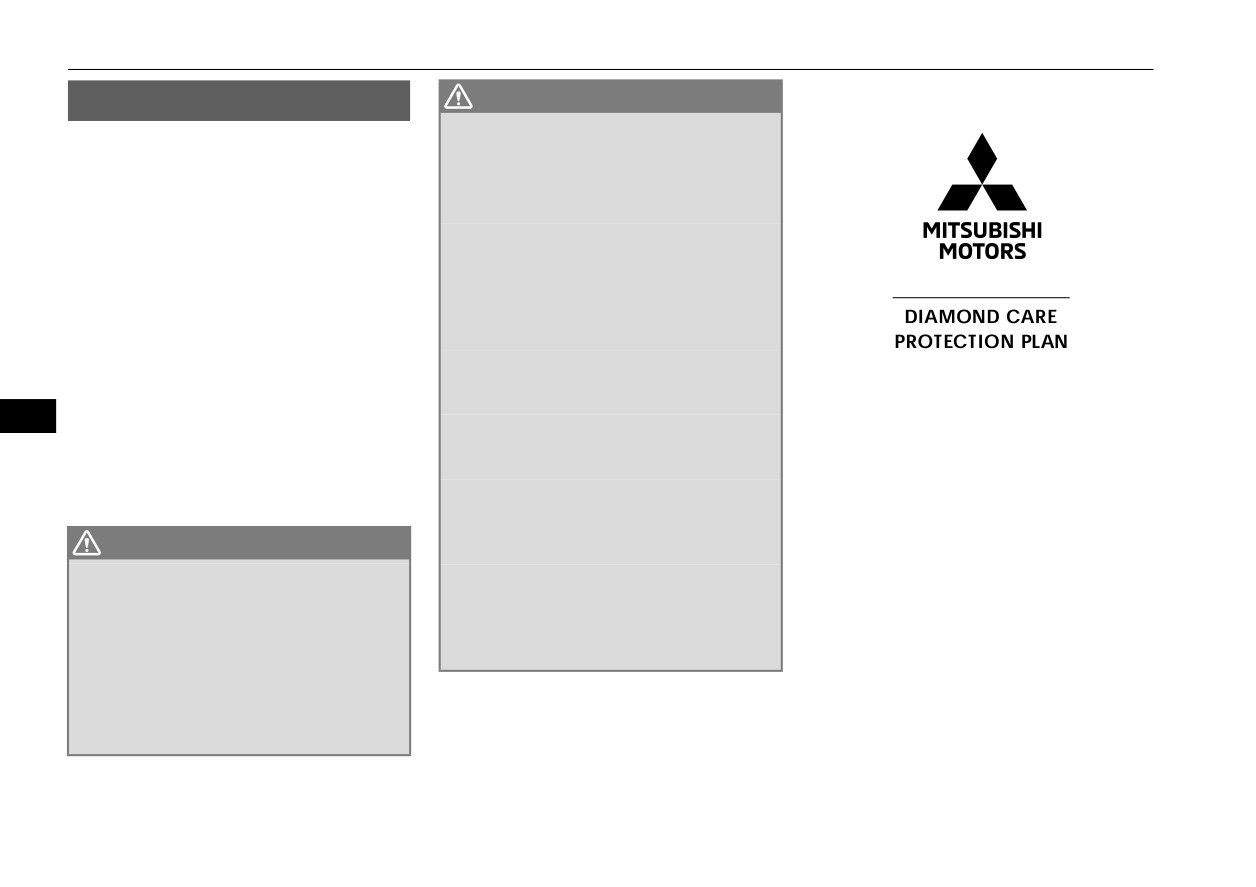
Service precautions
Service precautions
WARNING
N00937301599
z
After performing the maintenance work,
make sure that no tools or cloths are left
Taking regular care of your vehicle will pre-
behind in the engine compartment.
serve its value and appearance as long as pos-
If they are left behind, a fire or damage to
sible.
the vehicle may occur.
z
The fan can turn on automatically even if
You can do some of the maintenance work
the engine is not running. Turn the igni-
yourself, and the rest should only be per-
tion switch to the “OFF” position or put
formed by an authorized Mitsubishi Motors
the operation mode in OFF to be safe
dealer or a repair facility of your choice.
while you work in the engine compart-
If you discover a malfunction or other prob-
ment.
lem, have it corrected by an authorized
z
Do not smoke or allow open flames around
Mitsubishi Motors dealer or a repair facility
fuel or the battery. The fumes are flamma-
of your choice.
ble.
Have you purchased the Mitsubishi Motors
9
This section describes the maintenance
z
Be extremely careful when working
Diamond Care Protection Plan? The Plan
inspections that you can do yourself, if you so
around the battery. It contains poisonous
and corrosive sulfuric acid.
supplements your new vehicle warranties.
desire. Follow the instructions and precau-
z
Do not get under your vehicle while it is on
See your authorized Mitsubishi Motors dealer
tions for each procedure.
a jack.
for details.
Always use properly rated automotive
WARNING
jack stands.
z When checking or servicing the inside of
z
Handling your vehicle’s parts and materi-
the engine compartment, be sure the
als in the wrong way can injure you. Ask
engine is stopped and has had a chance to
an authorized Mitsubishi Motors dealer
cool down.
or a repair facility of your choice if you
z If you need to work in the engine compart-
have questions.
ment with the engine running, be espe-
cially careful that your clothing, hair, etc.
does not get caught in the fan, drive belts,
or other moving parts.
9-2
Vehicle care and maintenance
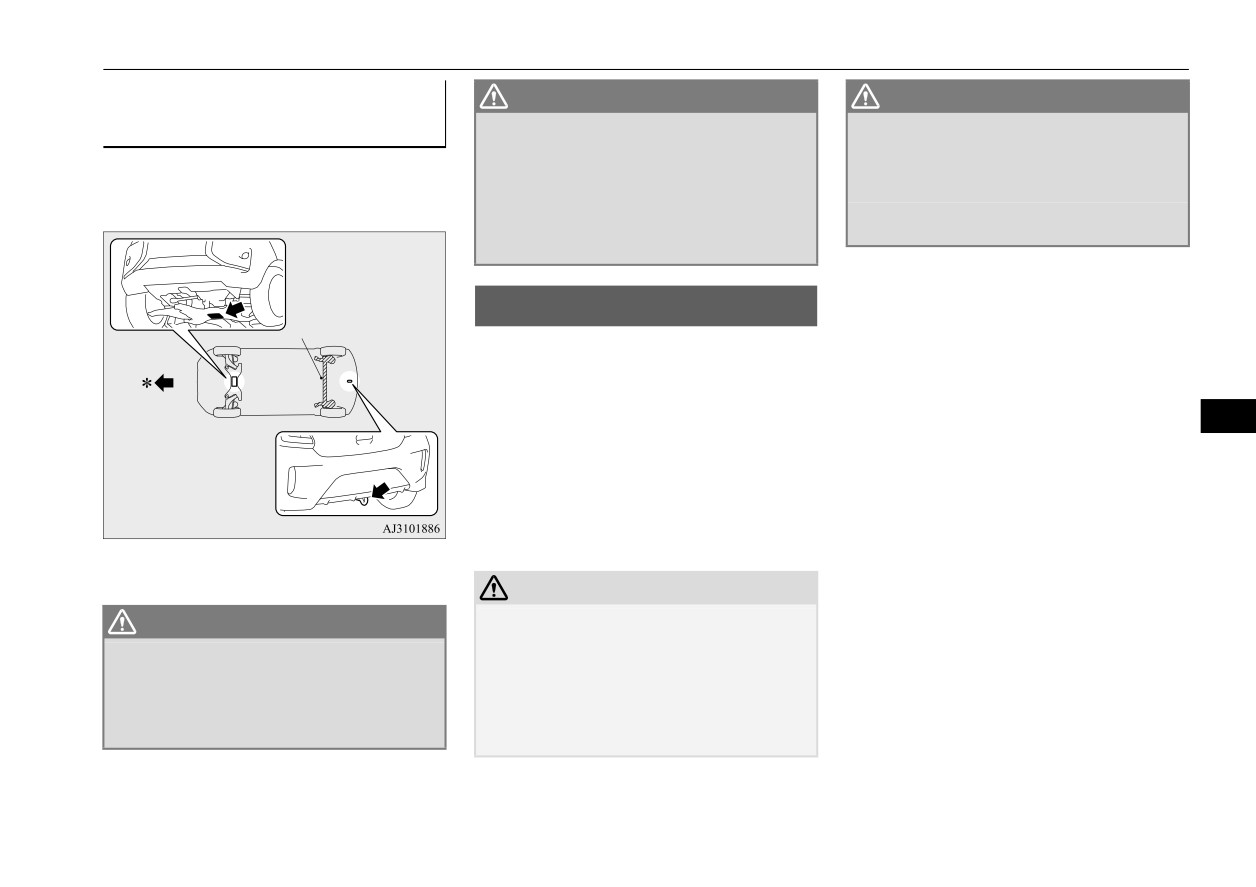
Catalytic converter
If your vehicle is raised with a
WARNING
WARNING
garage jack
z Do not use the jack on a tilted or soft sur-
z Do not park or run your vehicle in areas
face.
where combustible materials such as dry
Only use the designated positions shown in
Otherwise, the jack might slip and cause
grass or leaves can come in contact with a
personal injury. Always use the jack on a
hot exhaust, since a fire could occur.
the illustration.
flat, hard surface. Before setting the jack,
z Do not put undercoat paint on the cata-
make sure there are no sand or pebbles
lytic converter.
under the jack base.
Never use the rear
To reduce the possibility of catalytic con-
suspensions as a jack-
Catalytic converter
verter damage:
ing point.
N00937400450
z
Use UNLEADED GASOLINE ONLY of
The catalytic converter requires you to use
the type of recommended in the “Fuel
unleaded fuel only. Leaded gasoline will
selection”.
destroy the emission-control effectiveness of
z
Do not drive with an extremely low fuel
9
the converter.
level. Running out of gas could damage
the catalytic converter.
Normally, the catalytic converter does not
z
Do not try to start the engine by pushing
require maintenance. However, it is important
or towing the vehicle. If the battery is
to keep the engine properly tuned for the con-
weak or run down, use jumper cables to
verter to continue to work properly.
properly start the engine.
*- Front of the vehicle
z
Do not idle the engine with any spark plug
CAUTION
wires disconnected or removed, such as
z Damage to the catalytic converter can result
when performing diagnostic tests.
WARNING
if your vehicle is not kept in proper operating
z
Do not idle the engine for a long time if it
z Set a garage jack only at the
position
condition. If the engine malfunctions or mis-
is idling roughly or otherwise obviously
shown here. If the garage jack is set a
fires, or if your vehicle performance suffers,
wrong position, it could damage your
malfunctioning.
have it serviced promptly. Running your
vehicle and/or your vehicle might fall
z
To prevent the catalytic converter from
vehicle when it is overheated may result in
from the jack causing injury or death.
being damaged from unburned gas, do not
damage to the converter and vehicle.
race the engine when stopping the engine.
Vehicle care and maintenance
9-3
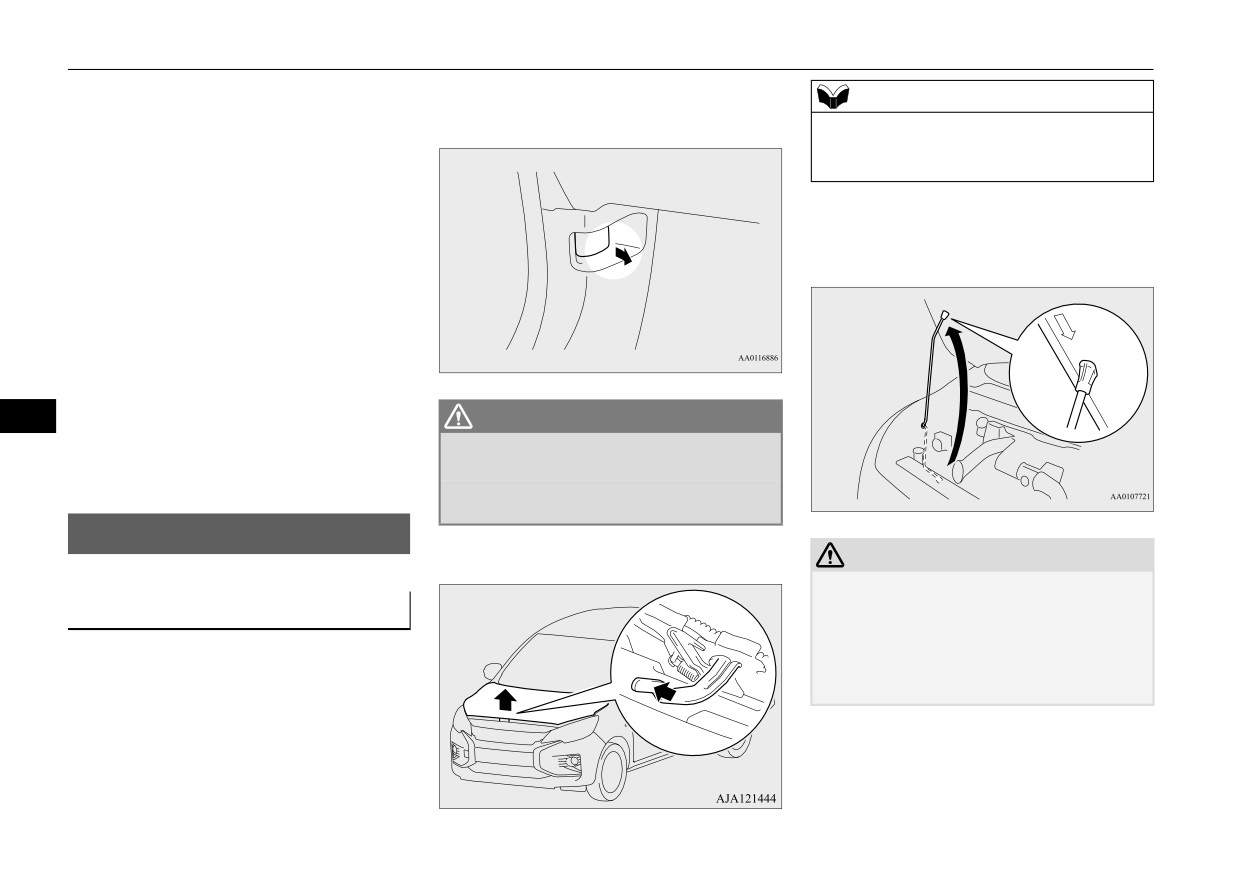
Engine hood
z
Stop driving the vehicle if you think the
Pull the lever toward
you
to
release
the
NOTE
performance is noticeably low, or the
engine hood latch.
z To prevent damage to the engine hood and
engine has a malfunction such as with the
wipers, make sure the wipers are at resting
ignition, etc. If you are not able to stop
position when you open the engine hood.
driving immediately, slow down and drive
for only a short time. Have your vehicle
Support the engine hood with the hood prop.
checked at an authorized Mitsubishi
Insert the hood prop securely in the opening
Motors dealer or a repair facility of your
under the hood marked with an arrow.
choice as soon as possible.
z
In unusual situations involving major
engine problems, a burning odor may
indicate severe and abnormal catalytic
converter overheating. If this occurs, stop
in a safe place, shut the engine off and let
the vehicle cool. Once the engine is cool,
9
WARNING
immediately take your vehicle to a dealer
z
Never use the release lever to unlatch the
or a repair facility of your choice for ser-
engine hood while the vehicle is in motion.
vice.
z
Do not drive your vehicle unless the
engine hood is locked.
Engine hood
Release the lever and lift the engine hood.
N00937501719
CAUTION
z
Always insert the support prop into the hole
specially made for it. Propping the engine
To open
hood at any other place could cause the prop
to slip out and lead to an accident.
Use the engine hood release lever (located
z
The hood prop can fall out if the hood is
under the instrument panel near the driver’s
lifted by a strong wind.
door) to unlock the engine hood.
9-4
Vehicle care and maintenance

View of the engine compartment
8- Engine coolant reservoir
To close
NOTE
z If this does not close the engine hood prop-
Unlatch the prop from the engine hood and
erly, drop it again from a slightly higher
Engine oil and oil filter
put it back in its retainer.
position.
N00937702154
z Do not push down strongly on the engine
hood. Depending on how strongly or where
To check and refill engine oil
you push down, you could create a dent in
the vehicle body.
It is normal for an engine to use oil. You may
need to add oil between the recommended oil
change intervals. Before starting the engine,
View of the engine compart-
check the engine oil level. Refill if necessary.
ment
N00937601794
To check the oil level, remove the dipstick,
wipe it off, and gently reinsert it all the way.
9
Slowly pull the dipstick straight out and
Slowly lower the engine hood approximately
check the oil level by checking the upper sur-
8 inches (20 cm), then let it drop from its own
face of the dipstick. The oil level must not go
weight.
above the line on the dipstick.
CAUTION
NOTE
z Be careful not to trap your hands or fingers
z If it is difficult to verify the oil level, wipe
when closing the engine hood.
off the dipstick and reinsert it. Wait a
z Make sure the engine hood is firmly closed
moment and then recheck the oil level by
before driving.
checking the upper surface of the dipstick.
1- Engine oil level dipstick
If you drive without the engine hood com-
2- Air cleaner filter
pletely closed, it could open up while driv-
3- Battery
ing.
4- Brake fluid
5- Windshield and rear window washer
fluid reservoir
6- Engine oil filler cap
7- Radiator cap
Vehicle care and maintenance
9-5

Engine oil and oil filter
If the level does not reach the line which
If you cannot find oils with the ILSAC certi-
NOTE
shows the minimum amount of oil required,
fication symbol, use an API classification SP
z Engine oil consumption is greatly influenced
remove the oil filler cap on the engine valve
or higher oil with the following label.
by payload, engine speed, etc.
cover, and fill to within the “Good” range.
This mark appears on the top of the oil con-
z The engine oil will deteriorate rapidly if the
tainer and tells you two important things
vehicle is subjected to severe conditions (for
about the oil.
example, repeated operation on rough roads,
in mountainous regions, on roads with many
Good
uphill and downhill gradients, or over short
API service symbol
distances). Consequently, the oil will require
earlier replacement in accordance with the
schedule in the “WARRANTY AND MAIN-
TENANCE MANUAL”.
Engine oil identification mark
9
Mitsubishi Motors recommends using only
CAUTION
engine oils with the ILSAC certification sym-
1-
The upper part indicates the quality of
z
Overfilling will cause oil aeration and loss of
bol on the front of the container.
oil pressure, which could damage the engine.
the oil.
2-
The center part indicates the SAE grade
ILSAC certification symbol
of the oil viscosity.
WARNING
z
Used engine oil is poisonous, and can dam-
age your skin. Prolonged and repeated
contact may cause serious skin disorders,
including dermatitis and cancer. Do not let
used oil touch your skin and wash thor-
oughly after working with it.
z
Keep used oil out of the reach of children.
9-6
Vehicle care and maintenance
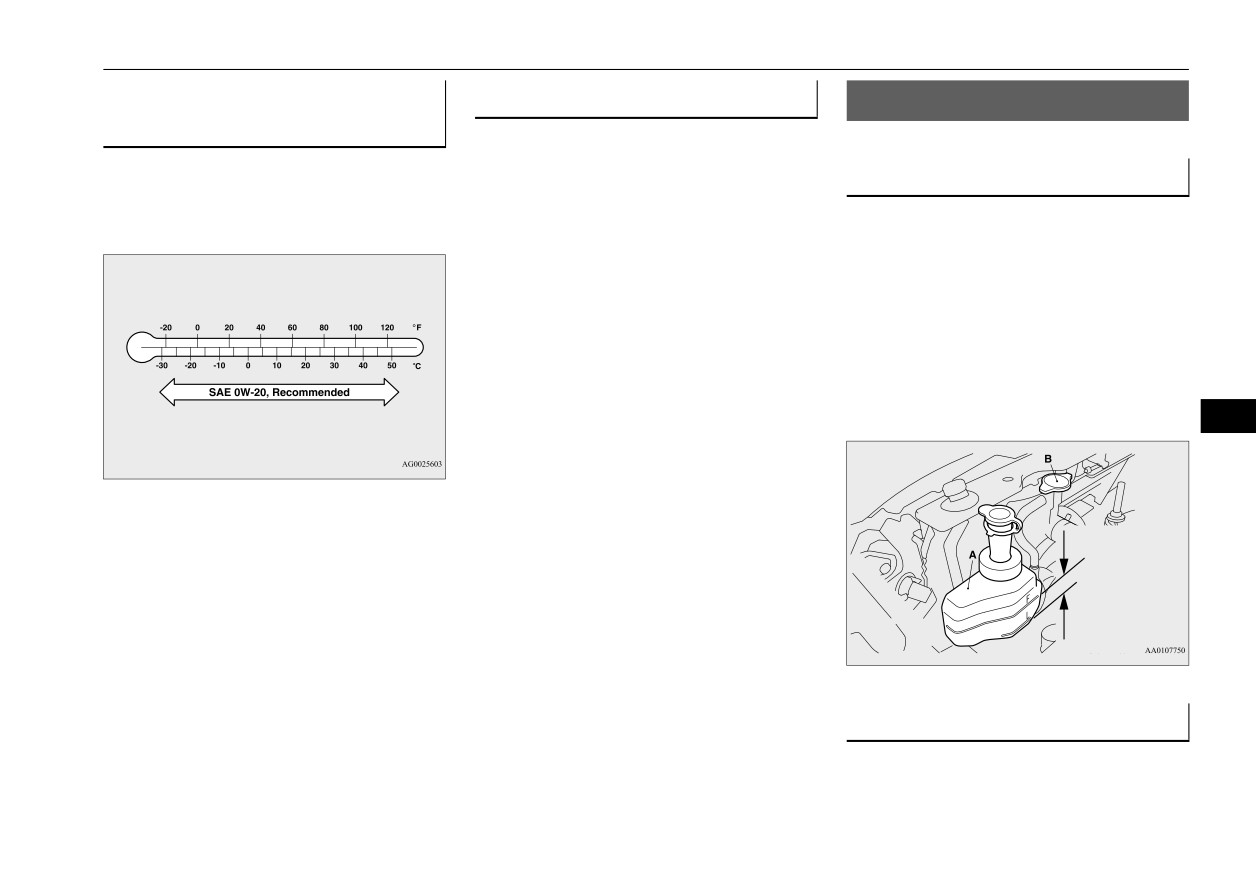
Engine coolant
Recommended engine oil vis-
To replace the oil filter
Engine coolant
cosity
N00937801679
The oil filter should be replaced at the time or
Use engine oil with the proper thickness for
mileage specified in the “WARRANTY AND
To check the coolant level
the outdoor temperatures where you will be
MAINTENANCE MANUAL”.
driving.
Only use high quality replacement filters on
The engine coolant reservoir
(A) lets you
this vehicle. The manufacturer’s specifica-
quickly see when you need to add coolant.
tions for Mitsubishi Motors Genuine oil fil-
When the engine is cold, the level of the cool-
ters require that the filter can withstand a
ant in the reservoir should be between the “F”
pressure of 256 psi (1.8 MPa). A Genuine
(FULL) and “L” (LOW) marks. The radiator
Mitsubishi oil filter is the best replacement
usually stays full so there is no reason to
filter.
remove the radiator cap (B) except when you
Follow the installation instructions printed on
check the coolant freeze point or replace the
the filter.
antifreeze coolant.
9
Mitsubishi Motors Genuine 0W-20 Synthetic
Engine Oil is recommended for optimum fuel
FULL
economy and cold weather starting.
If Mitsubishi Motors Genuine 0W-20 Syn-
LOW
thetic Engine Oil is not available,
5W-20
grade oils displaying the ILSAC certification
can be used.
However, Mitsubishi Motors Genuine 0W-20
Synthetic Engine Oil should be used at the
next oil change to maintain optimum fuel
To add coolant
economy and cold weather starting.
Use “Mitsubishi Motors Genuine Super Long
Life Coolant Premium” or equivalent*.
Vehicle care and maintenance
9-7
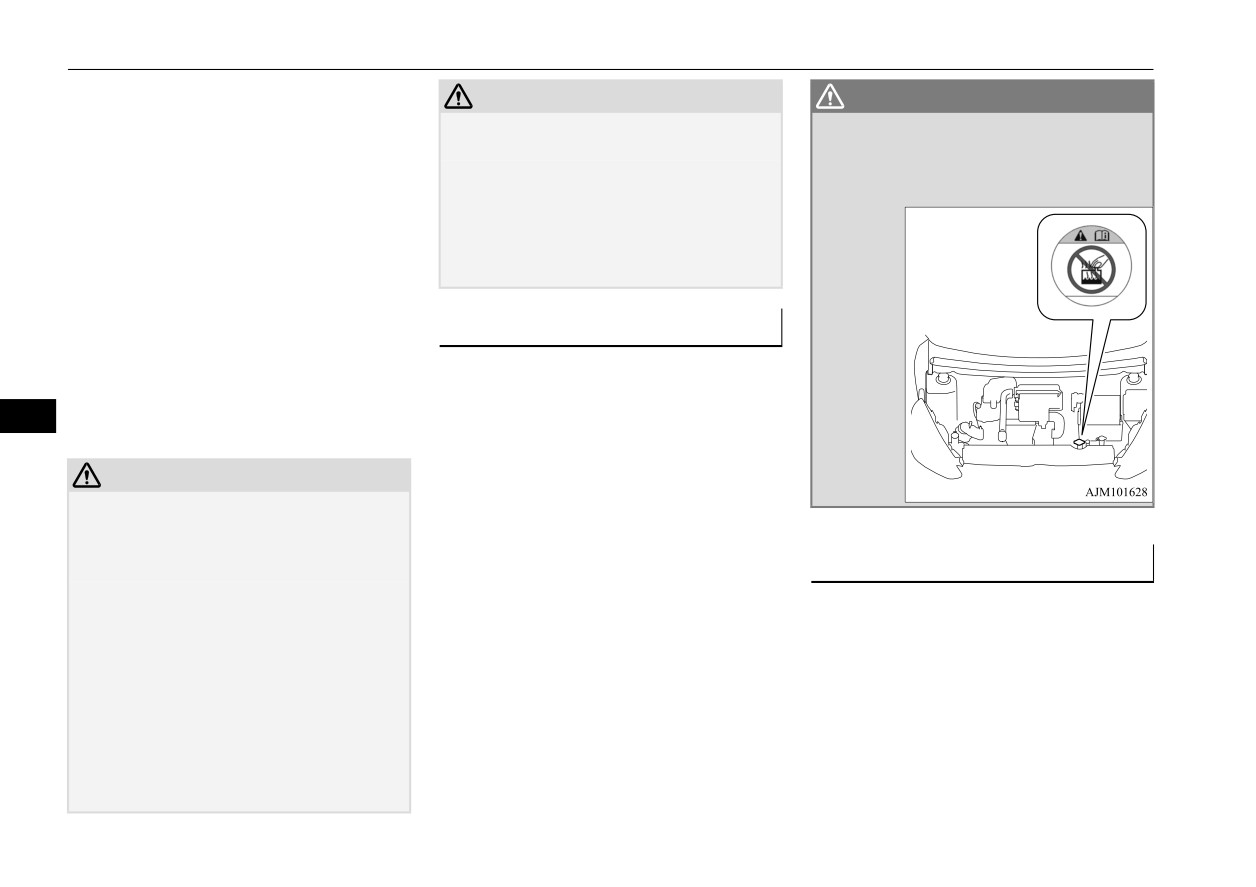
Engine coolant
*: similar high quality ethylene glycol
CAUTION
WARNING
based non-silicate, non-amine, non-
z Do not use water to adjust the concentration
z
Wait for the engine to cool down before
nitrate and non-borate coolant with long
of coolant.
opening the radiator cap. Otherwise hot
life hybrid organic acid technology
z Do not top off the reservoir with plain water
steam or boiling coolant could spray up
only. Water by itself boils at a lower temper-
from the filler port and scald you.
Mitsubishi Motors Genuine Coolant provides
ature and does not stop rust or freezing. If the
excellent protection against corrosion and
water freezes, it will damage your cooling
rust formation on all metals, including alumi-
system. Do not use tapwater. It can cause
num, and prevents clogs in some parts of the
corrosion and rust.
engine.
If you need to add coolant often, or if the
Radiator cap
level in the reservoir does not drop when the
engine cools, the cooling system should be
pressure-tested for leaks. Take your vehicle to
The radiator cap must be sealed tight to pre-
an authorized Mitsubishi Motors dealer or a
vent losing coolant, which may result in
9
repair facility of your choice for testing.
engine damage. Only use a
Mitsubishi
Motors Genuine Parts
radiator
cap,
or
an
approved equivalent.
CAUTION
z
Do not use alcohol or methanol antifreeze or
any engine coolants that contain them. Using
the wrong antifreeze can corrode aluminum
parts.
Points to remember
z
The required concentration of anti-freeze dif-
fers depending on the expected ambient tem-
z Do not overfill the reservoir.
perature.
z Your vehicle uses a special radiator cap
Above -31 °F (-35 °C) : 50 % concentration
that stays sealed and lets the coolant flow
of anti-freeze
from the reservoir back to the radiator
Below -31 °F (-35 °C) : 60 % concentration
when the engine cools down. If you need
of anti-freeze
to change the cap, use the exact same
You can check the concentration level with a
kind.
gauge from an automotive supply store, or
your authorized Mitsubishi Motors dealer or
service station can check it for you.
9-8
Vehicle care and maintenance
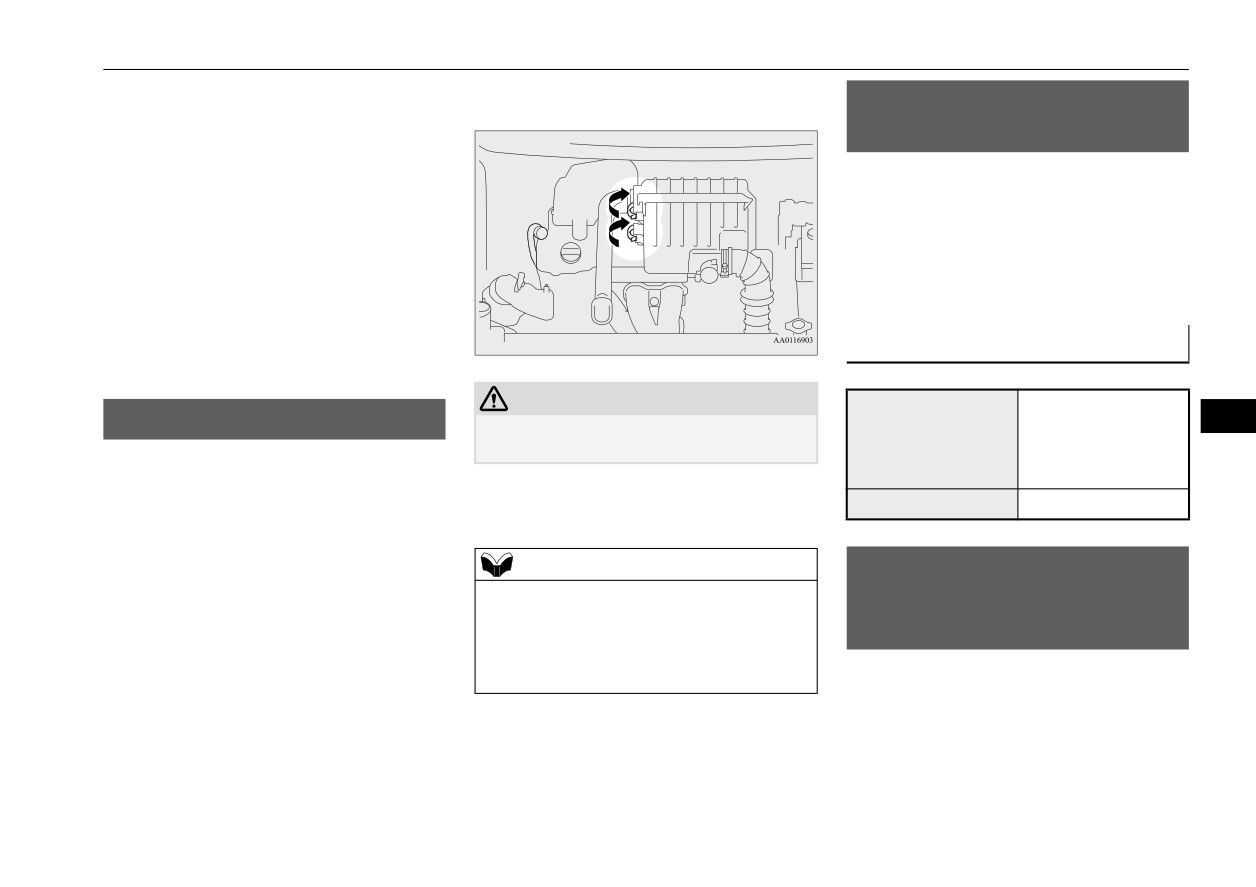
Air cleaner filter
z Check the coolant freeze point in the radi-
1. Unclamp the cover. Open up the top of the
Manual transaxle oil (if so
ator with the proper gauge, and only when
cover and take out the air cleaner filter.
it is safe. If you add antifreeze, the con-
equipped)
tents of the reservoir must be protected
N00938201205
against freezing.
z Keep the front of the radiator and con-
Whenever the manual transaxle oil level is
denser clean.
checked, add oil to maintain the proper level,
z If the engine coolant temperature does not
if necessary.
rise after the engine is warmed-up, take
Refill or change with the oil according to the
your vehicle to an authorized Mitsubishi
table below.
Motors dealer or a repair facility of your
choice to have the thermostat checked,
Oil type
and replaced if necessary.
CAUTION
Mitsubishi Motors
Air cleaner filter
9
z Take care not to scratch the engine air flow
Genuine NEW
Lubricant
N00937901540
sensor when removing the air cleaner cover.
MULTI GEAR OIL
The air cleaner filter will get dirty and dusty
ECO API GL-4
from use and not filter properly. Replace it
2. Replacing the air cleaner filter and put the
Viscosity range
SAE 75W-80
with a new filter using the schedule in the
cover back on in its original position.
“WARRANTY AND MAINTENANCE
MANUAL”.
NOTE
Continuously variable
z Genuine Mitsubishi Motors Parts are recom-
transmission (CVT) fluid (if
mended when replacing the air cleaner filter.
so equipped)
z After replacing the air cleaner filter, make
sure that the hinges at the bottom of cover
N00938101187
are firmly set.
The continuously variable transmission
(CVT) should be maintained and serviced by
an authorized Mitsubishi Motors dealer or a
repair facility of your choice to obtain the
best performance and longest life. It is impor-
Vehicle care and maintenance
9-9
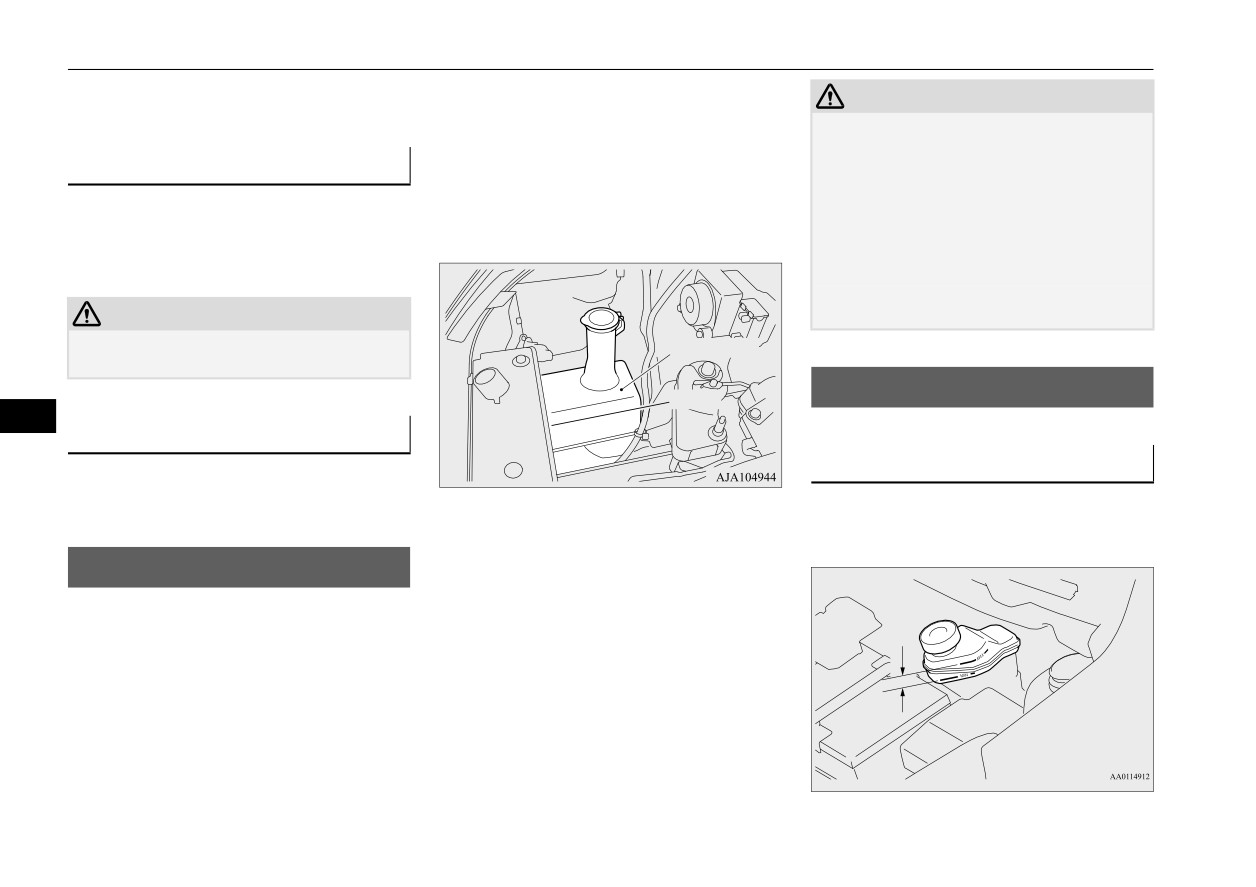
Washer fluid
tant that the transmission fluid is kept at the
Check the washer fluid level at regular inter-
CAUTION
correct level.
vals and add washer fluid to reservoir if nec-
z Do not use any fluid other than washer fluid.
essary.
Also, do not use such as soapy water, glass
Open the reservoir cap and check the level of
Fluid type
cleaner, and engine coolant. Using other liq-
washer fluid.
uids can cause damage to the vehicle, such as
Full level is approximately 2 inches (5 cm)
could cause streaking on the vehicle’s
Use only
“Mitsubishi Motors Genuine
below from the upper surface of the reservoir.
painted surfaces, damage to the washer
CVTF-J4 or CVTF-J4+” transmission fluid to
pump, or clogging the nozzle, leading to the
ensure optimum transmission performance.
washer fluid not spraying.
z Over-diluting the washer fluid in winter may
CAUTION
cause it to freeze onto the windshield.
z Using the improper transaxle fluid may dam-
Upper surface
age the transaxle.
Brake fluid
Full
N00938701314
9
Special additives
To check the fluid level
Do not use any fluid additives to the trans-
mission.
When freezing weather is anticipated, flush
The fluid level must be between the “MAX”
and “MIN” marks on the reservoir.
out the water in the reservoir by operating the
pump. Fill the reservoir with windshield anti-
Washer fluid
freeze (not radiator antifreeze), and operate
N00938601430
the system for a few seconds to flush out the
The windshield and rear window washer fluid
residual water.
MAX
reservoir is in the engine compartment.
MIN
9-10
Vehicle care and maintenance

Battery
The fluid level falls slightly with wear of the
Do not fill above the top line because a spill
CAUTION
brake pads, but this does not indicate any
during driving could cause damage.
z
Do not let any petroleum-based fluid touch,
abnormality.
mix with, or get into the brake fluid. This
will damage the seals.
The fluid in the master cylinder should be
z
Be careful when handling brake fluid. It can
checked when doing other work under the
damage painted surfaces.
engine hood. The brake system should also be
z
Use only the listed brake fluid. Different
checked for leaks at the same time.
brands of brake fluid have different addi-
If the fluid level falls noticeably in a short
tives, and these can cause a chemical reac-
length of time, it indicates leaks from the
tion. Do not mix brands of brake fluid.
brake system.
z
Keep the reservoir cap closed to keep the
If this occurs, have the vehicle checked by an
brake fluid from evaporating.
authorized Mitsubishi Motors dealer or a
repair facility of your choice.
Battery
WARNING
9
Fluid type
N00939100943
z
If the battery goes flat, be sure to check
The condition of the battery is very important
the battery electrolyte level before con-
Use the brake fluid conforming to DOT 3 or
for quick starting and to keep the vehicle’s
necting booster cables.
DOT 4. The reservoir cap must be tightly
electrical system working properly. Check the
z
After checking the battery electrolyte
sealed to keep dirt and water out.
battery regularly.
level, make sure the caps are fitted
securely.
z
If any of the caps has a loose fit, replace
WARNING
Checking battery electrolyte
the battery.
z Take care in handling brake fluid as it is
level
harmful to the eyes, may irritates your
N00901500072
skin and will damage painted surfaces.
Wipe up spills immediately.
The electrolyte level must be between the
During cold weather
If brake fluid gets on your hands or in
limits shown on the outside of the battery. Fill
N00901600060
your eyes, flush immediately with clean
it with distilled water as needed. The inside of
The battery is weaker in cold temperatures.
water. Follow up with a doctor as neces-
the battery is divided into several compart-
This has to do with its chemical and physical
sary.
ments. Take the cap off of each compartment
properties and is why a very cold battery,
and fill to the mark.
especially one with a low charge, will have a
hard time starting your vehicle.
Vehicle care and maintenance
9-11

Battery
It is recommended that you have your battery
NOTE
WARNING
and charging system checked by an autho-
z
Loosen the nut (B) and then disconnect the
z
Electrolyte (battery acid) is made of corro-
rized Mitsubishi Motors dealer or a repair
battery cable from the positive (+) terminal.
sive diluted sulfuric acid. If it spills on
facility of your choice before the start of cold
nearby parts, it can crack, stain, or dis-
weather. If necessary, have it charged. This
Type 1
color them. And if it gets on your skin or
will provide more reliable starting, and longer
in your eyes, it can cause burns or blind-
battery life.
ness. Please observe the following han-
dling instructions:
• If electrolyte gets on plastic parts or
Disconnection and connection
other nearby parts, wipe it off with a soft
N00901701172
cloth or chamois soaked in a solution of
To disconnect the battery cable, stop the
water and neutral detergent then imme-
engine. Disconnect the negative (-) terminal
diately rinse the affected parts with
first, then the positive (+) terminal. To recon-
plenty of water.
Type 2
nect the battery, first connect the positive (+)
• If electrolyte gets on your hands or
9
terminal and then the negative (-) terminal,
clothes, rinse thoroughly with water. If
electrolyte gets in your eyes, flush them
before starting the vehicle.
with water immediately and get immedi-
ate medical attention.
NOTE
z
Open doors and windows in any closed
z
Open the terminal cover (A) before discon-
space where you may be charging or
necting or connecting the positive (+) termi-
working with the battery.
nal of the battery.
z
Always wear protective clothing and gog-
gles when working with the battery, or
WARNING
have a skilled automobile technician do it.
z
Never disconnect
the
battery
while
the
z
If you are quick-charging your battery,
engine is running, or you could damage
first disconnect the battery cables.
the vehicle’s electrical parts.
z
In order to prevent a short-circuit, be sure
z
Never short-circuit the battery. This could
to disconnect the negative
(-) terminal
cause it to overheat and be damaged.
first, and reconnect it last.
z
Keep sparks, cigarettes, and flames away
z
Battery posts, terminals and related acces-
from the battery because the battery could
sories contain lead and lead compounds.
explode.
Wash hands after handling.
9-12
Vehicle care and maintenance
Tires
• The measured pressure after the
NOTE
Tires
vehicle has been parked for at
z
Check each battery terminal for corrosion.
N00939201693
You can stop more corrosion by washing
least three hours,
with a solution of baking soda and water.
WARNING
or
Grease the posts and clamps after cleaning or
z
Driving with tires that are
• The measured pressure when the
tightening them.
worn, damaged or improperly
vehicle is driven less than 1 mile
z
Check to see that the battery is securely
installed and cannot be moved. Also check
inflated is dangerous.
(1.6 km) after having been
each terminal for tightness.
These type tire conditions will
parked for three hours.
z
If you will not be driving your vehicle for a
adversely affect vehicle perfor-
z
Maximum pressure: the maximum
long period of time, remove the battery and
store it in a place where the battery fluid will
mance.
permissible cold tire inflation
not freeze. The battery only should be stored
These type tire conditions can
pressure for this tire.
with a full charge.
also cause a tread separation
z
Recommended inflation pressure:
z
Before cleaning the battery, tighten all the
or blowout which may result
the inflation pressure for optimum
filler port caps to keep dirt and moisture out.
9
in an accident causing serious
tire performance.
injury or death.
z
Intended outboard sidewall:
z
Tires, including spare tire,
• The sidewall that contains a
degrade over time with age
whitewall, bears white lettering
even when they are not being
or bears manufacturer, brand,
used.
and/or model name molding that
It is recommended that tires
is higher or deeper than the same
over
6 years generally be
molding on the other sidewall of
replaced even if damage is not
the tire,
obvious.
or
It is important to familiarize yourself
with the following terms:
z Cold tire pressure:
Vehicle care and maintenance
9-13

Tires
• The outward facing sidewall of
z
Section width: the linear distance
Tire Markings
an asymmetrical tire that has a
between the exteriors of the side-
particular side that must always
walls of an inflated tire, excluding
face outward when mounted on a
elevations due to labeling, decora-
vehicle.
tion, or protective bands.
z
Passenger car tire: a tire intended
z
Bead: the part of the tire that is
for use on passenger cars, multi-
made of steel wires, wrapped or
purpose passenger vehicles, and
reinforced by ply cords and that is
trucks that have a gross vehicle
shaped to fit the rim.
weight rating
(GVWR) of
z
Ply: a layer of rubber-coated par-
10,000 pounds or less.
allel cords.
z
Light truck (LT) tire: a tire desig-
z
Cord: the strands forming the plies
1- Size Designation
nated by its manufacturer as pri-
in the tire.
2- Service Description
9
marily intended for use on
z
Rim: a metal support for a tire or a
3- Maximum Load
lightweight trucks or multipurpose
tire and tube assembly upon which
4- Maximum Pressure
passenger vehicles.
the tire beads are seated.
5- U.S. DOT Safety
Standards
z
Tread: portion of a tire that comes
z
Rim diameter: nominal diameter
Code (TIN)
into contact with the road.
of the bead seat.
6- Treadwear, Traction
and Tem-
z
Tread rib: a tread section running
z
Groove: the space between two
perature Grades
circumferentially around a tire.
adjacent tread ribs.
z
Tread separation: pulling away of
Size Designation
the tread from the tire carcass.
z
Carcass: the tire structure, except
EXAMPLE: P215/65R15
tread and sidewall rubber which,
Passenger car tire size based
when inflated, bears the load.
P
on U.S.A. design standards
z
Sidewall: portion of a tire between
the tread and bead.
9-14
Vehicle care and maintenance
Tires
Section width in millimeters
NOTE
Speed symbol
215
(mm)
z
LT (Light Truck)
-metric tire
A symbol indicating the
Aspect ratio in percent (%)
sizing is based on U.S.A. design
range of speeds at which a
65
Ratio of section height to
standards. The size designation
tire can carry a load corre-
section width of tire.
for LT-metric tires is the same as
sponding to its load index
for P-metric tires except for the
under certain operating con-
Construction code
letters “LT” that are molded into
ditions.
• “R” means radial construc-
the sidewall preceding the size
H
The maximum speed corre-
R
tion.
designation.
sponding to the speed sym-
• “D” means diagonal or bias
Example: LT235/85R16.
bol should only be achieved
construction.
under specified operating
z
Temporary spare tires are high
15
Rim diameter in inches (in)
conditions. (i.e. tire pressure,
pressure
compact
spares
vehicle loading, road condi-
9
designed for temporary emer-
NOTE
tions and posted speed lim-
gency use only. Tires designed
z
European/Japanese metric tire
its)
to this standard have the letter
sizing is based on European/Jap-
“T” molded into the sidewall
anese design standards. Tires
preceding the size designation.
Maximum Load
designed to these standards have
Example: T145/80D18 103M.
the tire size molded into the
Maximum load indicates the maxi-
sidewall beginning with the sec-
mum load this tire is designed to
Service Description
tion width. The letter
“P” is
carry.
absent from this tire size desig-
EXAMPLE: 95H
nation.
Load index
Example: 215/65R15 96H.
A numerical code associ-
95
ated with the maximum load
a tire can carry.
Vehicle care and maintenance
9-15
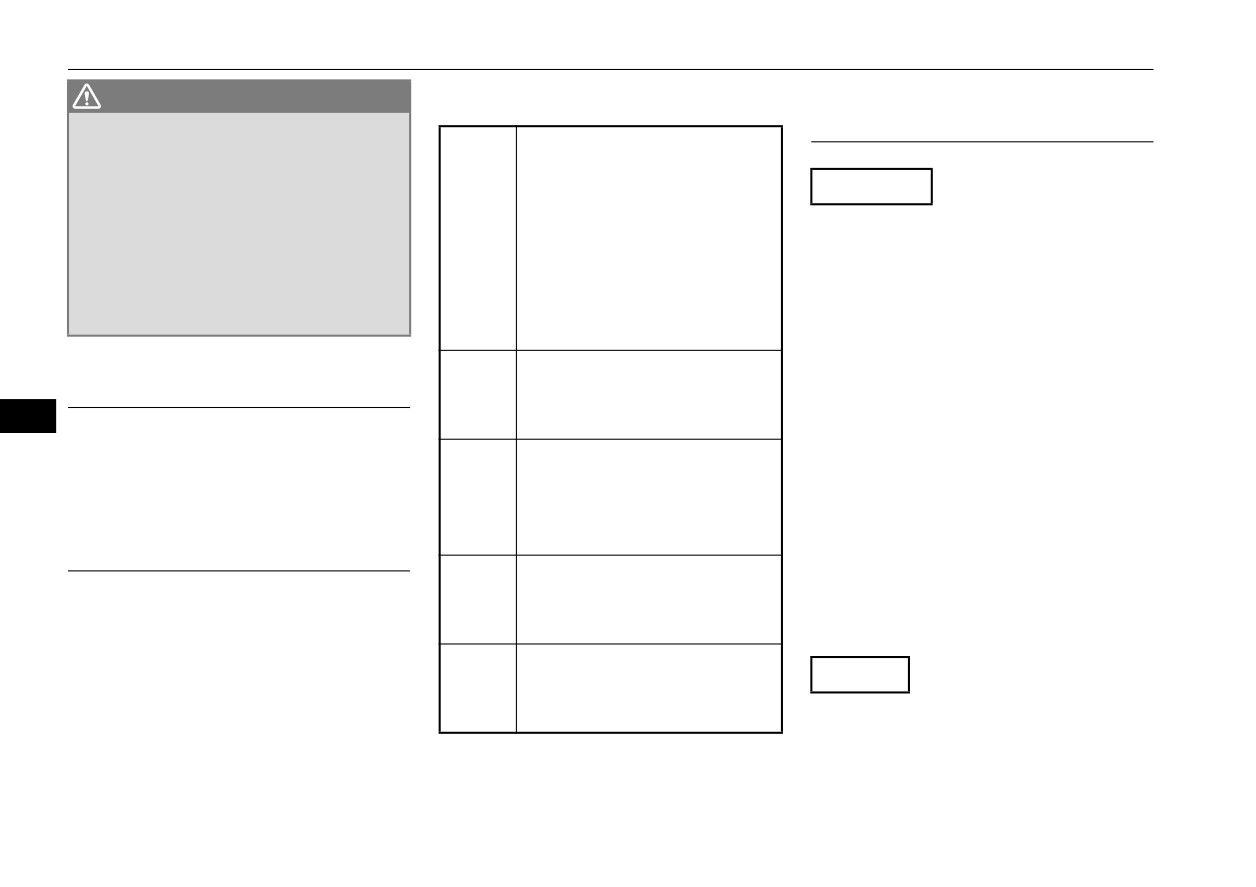
Tires
EXAMPLE: DOT MA L9 ABCD
WARNING
Treadwear, Traction and Temper-
1504
z Overloading of your tire is
ature Grades
Department of Transporta-
dangerous. Overloading can
tion
cause tire failure, affect vehi-
Treadwear
This symbol certifies that
cle handling, and increase
the tire is in compliance
The treadwear grade is a comparative
your stopping distance. Use
DOT
with the U.S. Department
rating based on the wear rate of the
tires of the recommended load
of Transportation tire safety
tire when tested under controlled
capacity for your vehicle.
standards, and is approved
conditions on a specified government
Never overload them.
for highway use.
test course. For example, a tire
Code representing the tire
graded 150 would wear one and one-
Maximum Pressure
MA
manufacturing location.
half (11/2) times as well on the gov-
9
(2 digits)
ernment course as a tire graded 100.
Maximum Pressure indicates the
Code representing the tire
The relative performance of tires
maximum permissible cold tire infla-
L9
size. (2 digits)
depends upon the actual conditions
tion pressure for this tire.
ABCD
Code used by tire manufac-
of their use, however, and may depart
turer. (1 to 4 digits)
significantly from the norm due to
Tire Identification Number (TIN)
variations in driving habits, service
Number representing the
practices and differences in road
15
week in which the tire was
The TIN may be found on one or
characteristics and climate.
manufactured. (2 digits)
both sides of the tire but the date
code may only be on one side. Look
Number representing the
Traction
for the TIN on the outboard side of
04
year in which the tire was
tires as mounted on the vehicle. If the
manufactured. (2 digits)
The traction grades, from highest to
TIN is not found on the outboard side
lowest, are AA, A, B and C. Those
then you will find it on the inboard
grades represent the tire’s ability to
side of the tire.
stop on wet pavement as measured
9-16
Vehicle care and maintenance
Tires
under controlled conditions on speci-
z Ride comfort and vehicle stability
Tire inflation pressures
fied government test surfaces of
The superior riding experience
N00939302079
asphalt and concrete. A tire marked
built into your vehicle partly
Proper tire inflation pressure is
C may have poor traction perfor-
depends on the correct tire pres-
essential for the safe and satisfactory
mance.
sure. Too much pressure gives an
operation of your vehicle. The wrong
uncomfortable and jarring ride.
tire pressure will cause problems in
Temperature
Too little pressure feels as if your
three major areas:
vehicle is slow to respond.
The temperature grades are A (the
z
Safety
Unequal tire pressures can make
highest), B and C, representing the
Too little pressure increases flex-
steering your vehicle uneven and
tire’s resistance to the generation of
ing in the tire and can cause tire
unpredictable.
heat and its ability to dissipate heat
failure. Too much pressure can
when tested under controlled condi-
The tire pressure for your vehicle
cause a tire to lose its ability to
9
tions on a specified indoor laboratory
under normal driving conditions is
cushion shock. Objects on the
test wheel. Sustained high tempera-
listed on the placard attached to the
road and potholes could then
ture can cause the material of the tire
driver’s door sill.
cause tire damage that may result
to degenerate and reduce tire life, and
(Refer to “Tire and loading informa-
in tire failure.
excessive temperature can lead to
tion placard” on page 11-3.)
z
Economy
sudden tire failure. The grade C cor-
The wrong tire pressure can cause
responds to a level of performance
uneven wear patterns in the tire
which all passenger car tires must
tread. These abnormal wear pat-
meet under the Federal Motor Vehi-
terns will reduce the tread life, and
cle Safety Standard No. 109. Grades
the tire will have to be replaced
B and A represent higher levels of
sooner.
performance on the laboratory test
Too little pressure also makes it
wheel than the minimum required by
harder for the tire to roll, and this
law.
uses up more fuel.
Vehicle care and maintenance
9-17
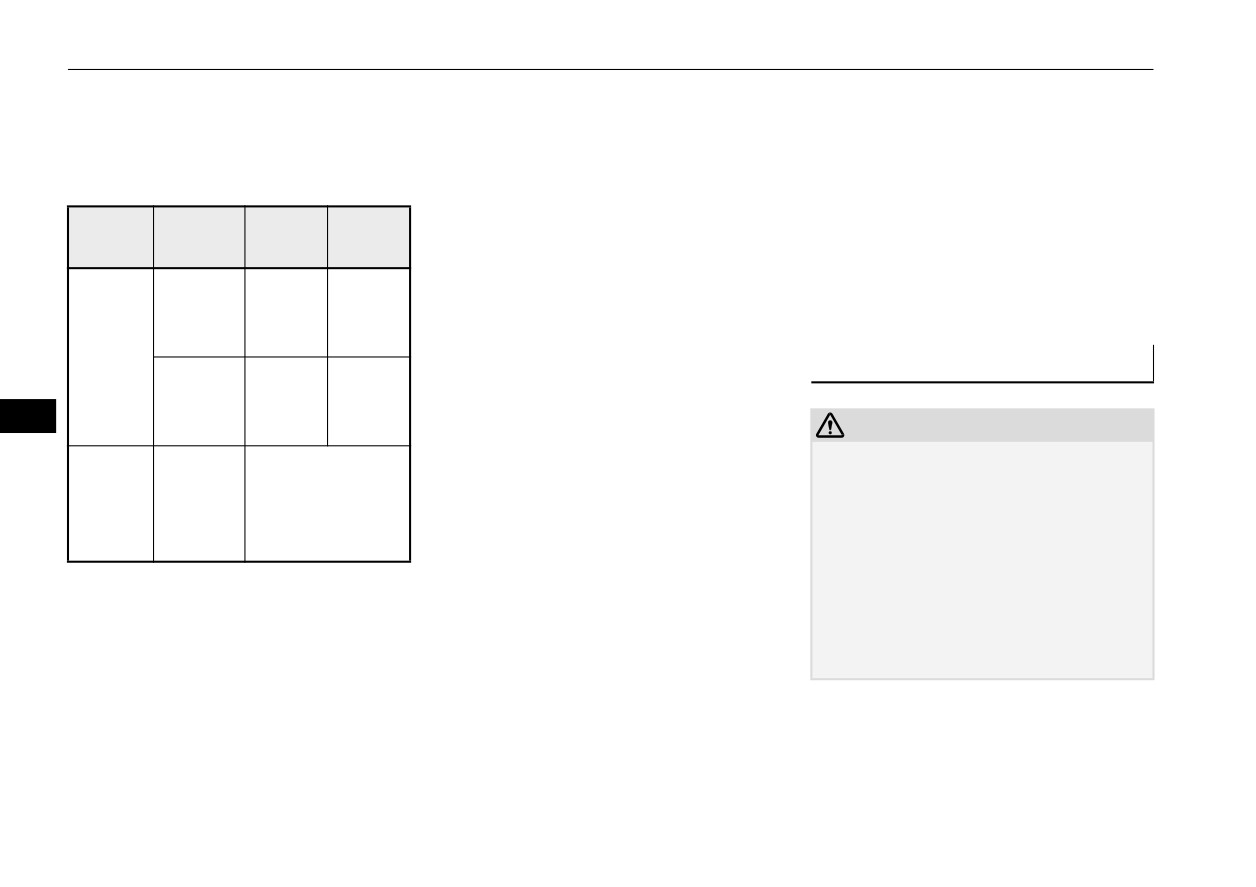
Tires
The recommended inflation pres-
Cold inflation pressure is measured
z Make sure that the weight of any
sures under normal driving condi-
after the vehicle has been parked for
load in your vehicle is evenly dis-
tions should be used for
the tires
at least three hours or is driven less
tributed.
listed below.
than
1 mile (1.6 km) after having
z Drive at safe speeds.
been parked for three hours.
z After filling your tires to the cor-
Tire
Cold inflation pressure must not go
rect pressure, check them for dam-
Item
Front
Rear
size
above the maximum values molded
age and air leaks. Be sure to
270
270
into the tire sidewall. After driving
reinstall the caps on the valve
165/65R
kPa,
kPa,
several miles, your tire inflation pres-
stems.
14
39 psi
39 psi
sure may increase 2 to 6 psi (14 to
Nor-
41 kPa) from the cold inflation pres-
Replacing tires and wheels
mal tire
240
240
175/55R
sure. Do not let air out of the tires to
N00939601482
kPa,
kPa,
15
get back to the specified cold pres-
9
35 psi
35 psi
CAUTION
sure, or your tires will be too low.
z
Avoid using different size tires from the one
Com-
Check your tires each time you
listed and the combined use of different
pact
T115/70
refuel. If one tire looks lower than
types of tires, as this can affect driving
420 kPa, 60 psi
spare
D14
safety.
the others, check the pressure for all
Refer to “Tires and wheels” on page 11-5.
wheel
of them.
z
If your vehicle is equipped with a tire pres-
You should also take the following
sure monitoring system, only Mitsubishi
Tire pressures should be checked,
Motors Genuine wheels should be used.
safety precautions:
and adjusted if necessary, at least
Use of another type of wheel risks air leaks
and sensor damage, as it will not be possible
once a month.
z Keep your tires inflated to the rec-
to install the tire pressure sensor properly.
Pressures should be checked more
ommended pressures. (See the tire
often whenever weather temperatures
and loading information placard
change severely, because tire pres-
attached to the driver’s door sill.)
sures change with outdoor tempera-
z Stay within the recommended
tures. The pressures listed are always
load limits.
“cold inflation pressure”.
9-18
Vehicle care and maintenance